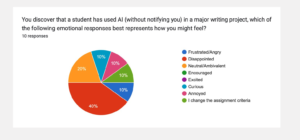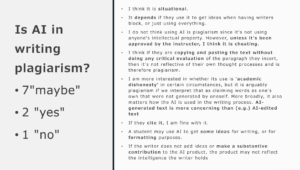Artificial Intelligence in Teaching & Learning
AI in Writing
Melanie Gagich
Facilitator: Melanie E. Gagich
Cofacilitator: Mike Okrent
Key Takeaways from the AI in Writing Discussion
The following was collected from a group Google Doc distributed on Thursday, March 9. Participants were asked to work with group members to discuss biggest concerns related to AI and writing, ideas or strategies to meet these concerns, and how AI might be incorporated into the classroom.
Biggest Concerns about AI and Potential Strategies
Biggest concerns include:
- That AI will foster “a reduction in [students’] ability to clearly communicate and think critically about idea”
- That using AI will lead to an “absence of ‘productive struggle’” and an “overwhelming reliance on AI for thinking”
Potential strategies include:
- Asking students to “write about something personal and their lived experiences”
- Approaching the teaching of writing as a process
- Scaffolding assignments
- “Chunking the assignment” to “help with not just submitting an AI created document”
How should AI be incorporated into classrooms? (the bulleted points were taken directly from the collaborative Google Doc)
Using AI to brainstorm
- Have students generate information about a topic
- Use it as reference for in-person, real time argumentation/debate
- Have students generate something from AI for a beginning and then launch from there
- Feed some topic or idea into ChatGPT and see what it pops out
Evaluating AI generated work as part of the writing process and/or assignment
- Bring in an AI generated example of the assignment as a starting point when discussing the assignment with students and work through what is good and not so good with students.
- Have students generate a text with AI and spend time evaluating it. Class discussion could center on: strengths, weaknesses, and how to use it as a tool (or) not for writing in a business environment [or other writing contexts].
- Have students identify inaccuracies, develop accurate ideas, cite the accurate ideas (since ChatGPT doesn’t cite or it makes up citations)
AI and Plagiarism
As a First-Year Writing instructor, one of the areas I was most interested in discussing was related to participants’ views of AI and plagiarism. A week or two prior to my facilitation of the AI in Writing discussion, I found that a student in one my First-Year Writing courses had used ChatGPT to help them write a paper. My initial reaction was one of shock, disappointment, and concern. However, after participating in this Faculty Learning Community, I began to question my immediate emotional responses. I found myself thinking that I need to work harder to clearly incorporate AI discussions into my classes and decided to ask my fellow community members how they felt about this issue.
The following images were collected from a short, informal survey distributed to the members of the AI Faculty Learning Community prior to the AI in Writing discussion on March 9.


Specific Resources Related to AI and Writing
- Anna Mill’s Presentation, “Teaching with AI: Using Writing Generators in the Classroom” from the Conference on College Composition and Communication, 2023
- Forbes Youtube video, “Generative AI is about to Reset Everything, and, Yes It Will Change Your Life”
- Jonathan McMichael’s, “Artificial Intelligence and the Research Paper: A Librarian’s Perspective” ,from Southern Methodist University
- John Warner’s “Freaking out About ChatGPT – Part I”, in Inside Higher Ed
- Dylan Selterman’s “GPTChat: The Point of Education and Communication” in Psychology Today
- Ben Chrisinger’s “It’s Not Just Our Students, ChatGPT is Coming for Faculty Writing”in The Chronicle of Higher Education
Assignment Idea:
- Melanie Gagich’s, “Argumentative Synthesis Assignment Sheet” (with a focus on AI and writing).
Citing ChatGPT:
- Check out this Scribbr article by Jack Caulfield that reviews various ways to document ChatGPT, “ChatGPT Citations: Formats and Examples.”


